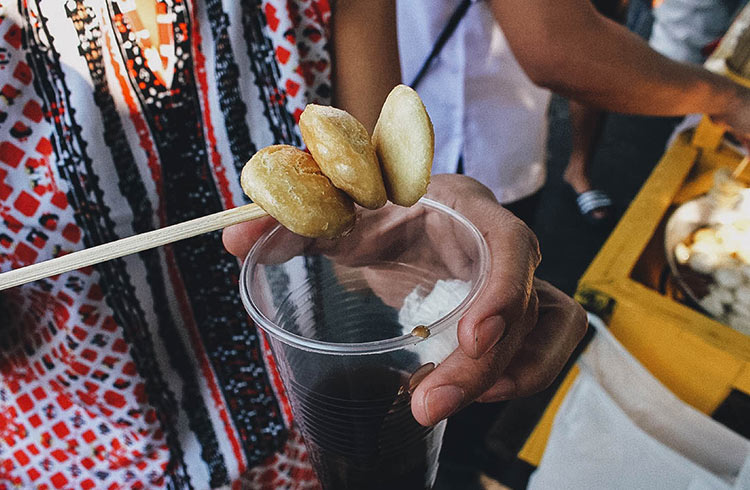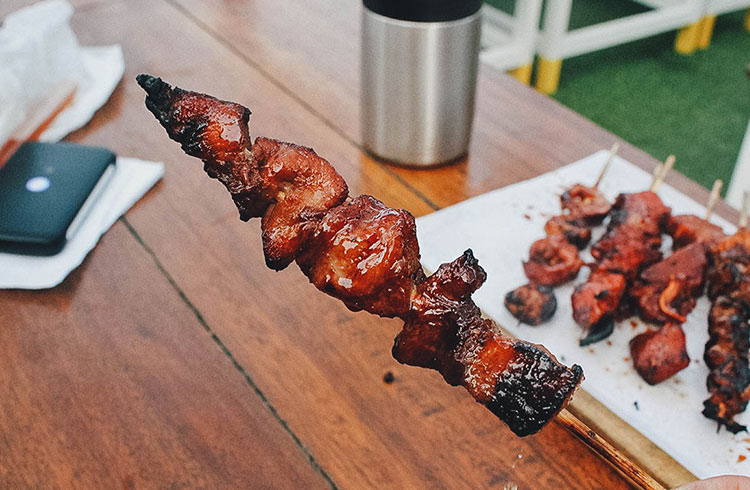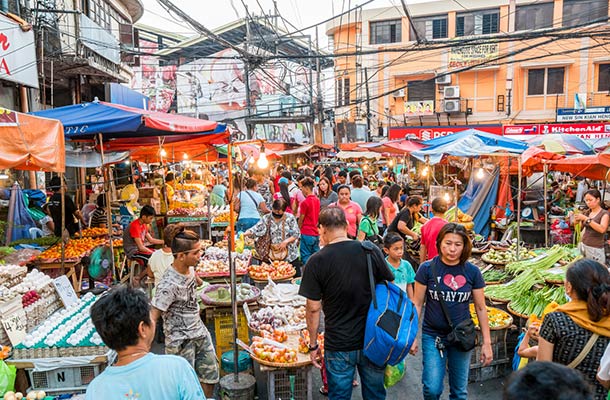Filipino Street Food: The Top Dishes to Try
Like its southeast Asian neighbors, street food in the Philippines is one of the best reasons to visit. With so many delicious things at your fingertips, which Filipino snacks and dishes should you try first? Local insider JB helps you navigate.
 Photo © JB Macatulad
Photo © JB Macatulad
- Must-eat Filipino street food
- Interesting origins of popular dishes and food names
- Best places to try street food in the Philippines
- A Local’s perspective on Filipino street food
Must-eat Filipino street food
If a traveler asked me what street food dish they should try first in the Philippines, I’d say inihaw. It’s less intimidating than more unusual dishes like the infamous balut (more on that later), and it refers to a family of dishes, not just one.
Inihaw means “grilled”, and typically refers to a group of skewered meat dishes, usually offal, that are basted with a sauce and grilled over charcoal. Commonly used cuts of meat include marinated pork, chicken or pork intestines, and pig ears. Savory and smoky, they're typically served with a vinegar chili dip and go well with beer.
Other recommended dishes include kwek kwek (hard-boiled quail eggs dipped in orange batter and deep-fried till crispy), and lugaw (rice porridge). Fish balls are among the most iconic Filipino street foods and consist of skewered balls of flour made with flaked fish meat. They’re served with a savory sweet sauce or a spiced vinegar dip.

On a rainy day, there’s nothing better than a bowl of lugaw. Served plain, or with chicken or pork offal, it’s a comforting dish that warms your soul. For dessert, try Banana Q, which is a skewered deep-fried sweet plantain coated in caramelized brown sugar.
Don’t forget to try banana ketchup; as its name suggests, it’s a sweeter type of ketchup made with bananas and goes well with greasy foods like fried chicken.
The interesting origins of popular Filipino street-food dishes and food names
The popularity of inihaw arose out of need. When an economic crisis hit the country in the 1970s, people were driven to find ways to save money. Less favorable animal parts, including pigs' ears and intestines, were carefully cleaned before being skewered and grilled on coals.
To make these less palatable cuts of meat more appealing, vendors came up with cute names to help sell them to the public. Rectangular blocks of congealed pigs' blood were called betamax, skewered chicken heads were known as a helmet, and grilled pigs' ears were referred to as walkman – amusing names which have endured to this day.

Best places to try street food in the Philippines
For a truly authentic experience, there’s no better place to have street food than by the side of a busy road. Vendors offering different types of street food often congregate in urban areas with a lot of foot traffic. In Manila, busy areas like Quiapo and Divisoria Market are hotbeds for street food. The noise, smells, heat, and grit are all part and parcel of a true Filipino street food experience.
But as authentic an experience as these places offer, they aren't for everyone. These areas are crowded and aren’t always the most pleasant or hygienic. Thankfully, street food has become so mainstream that you can find it in less gritty venues as well, like bars and food parks. Food parks are like outdoor food courts, comprised of many vendors selling different types of food. Nearly every food park we’ve been to has one or two vendors specializing in street food.
Go to any Filipino bar and the chances are you’ll find street food being offered as bar chow. For travelers getting their first taste of Filipino street food, this may be the more attractive option.

A local’s perspective on Filipino dishes
The thought of trying unfamiliar food can be intimidating. When it comes to Filipino street food, the one intimidating dish that comes to mind is balut, a fertilized duck egg that’s been incubated for up to 21 days and boiled. Believe me, it’s challenging even for many Filipinos.
As a local, I suggest you keep an open mind when trying Filipino street food – what you may think is unpalatable at first may turn out to be delicious. If you close your mind off to something, then you’ll never know what you could be missing.
We travel in order to step out of our comfort zone and experience something new. Street food, no matter how unfamiliar, is all part of the experience.
Related articles
Simple and flexible travel insurance
You can buy at home or while traveling, and claim online from anywhere in the world. With 150+ adventure activities covered and 24/7 emergency assistance.
Get a quote


No Comments